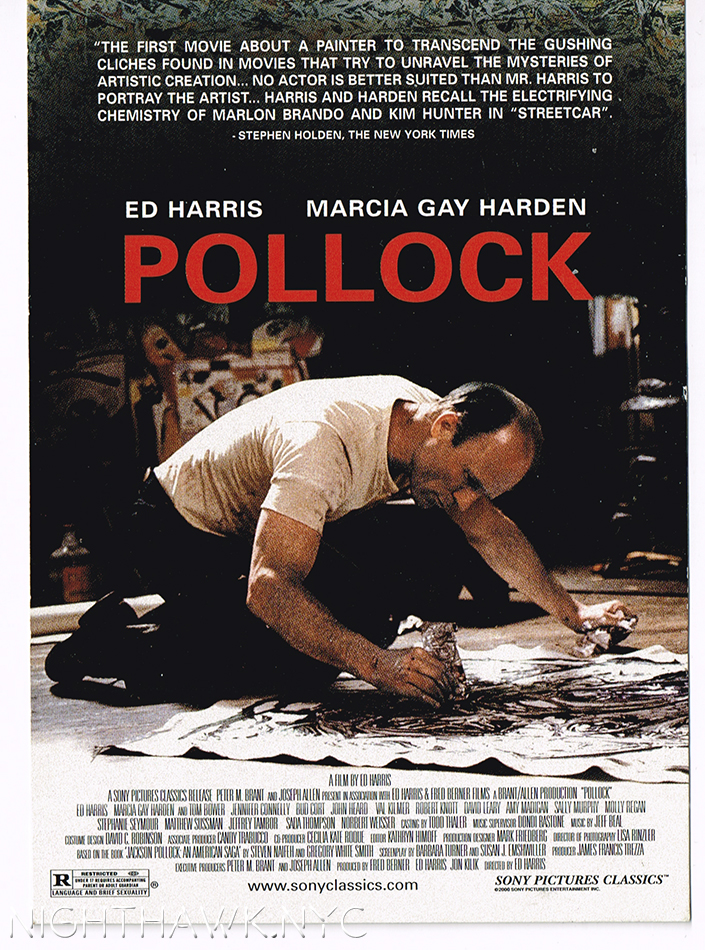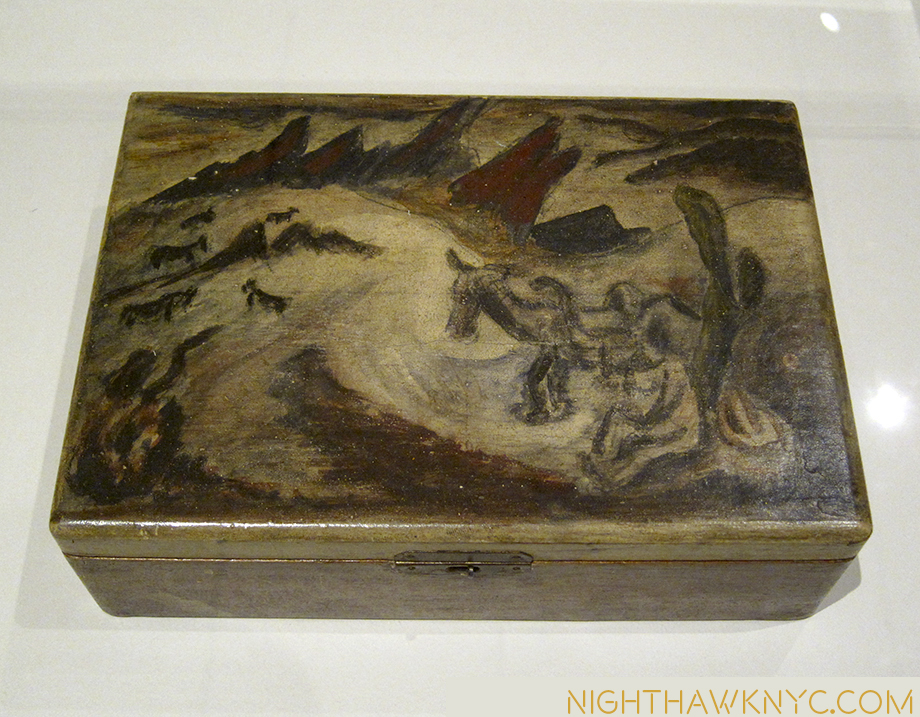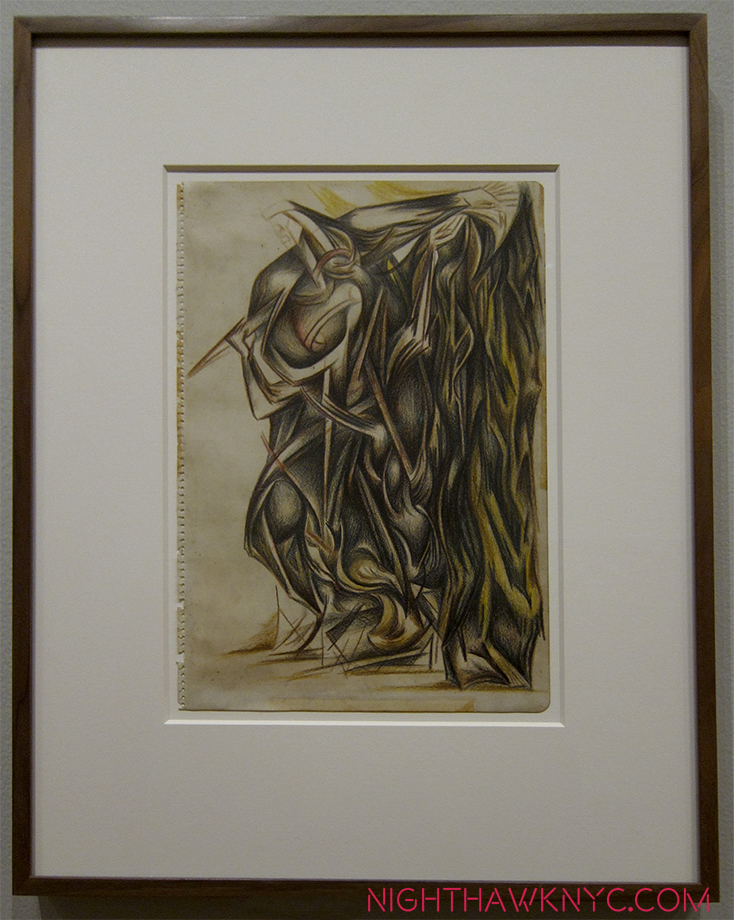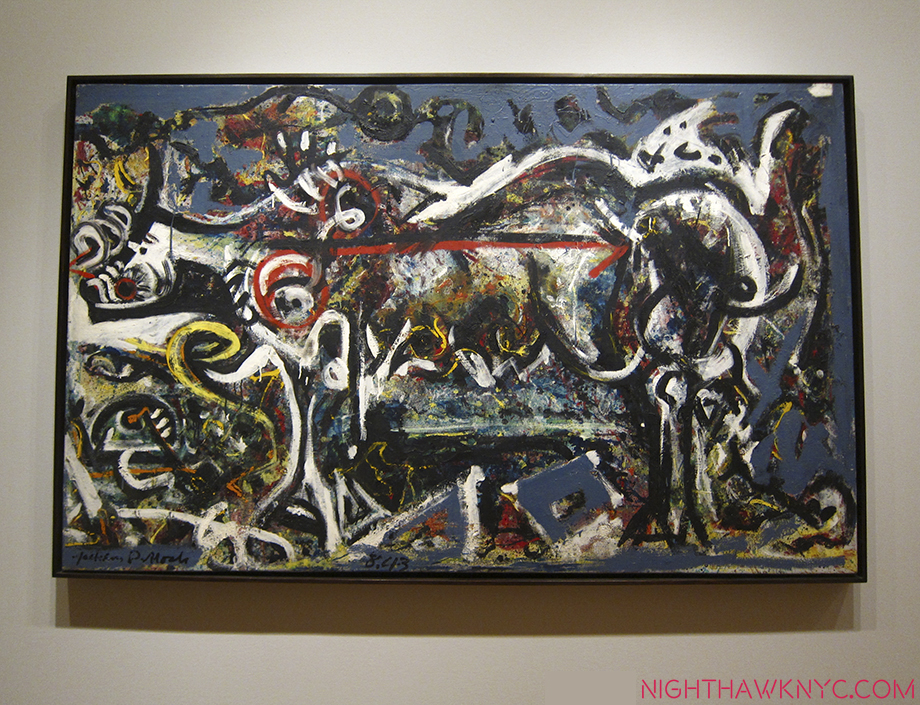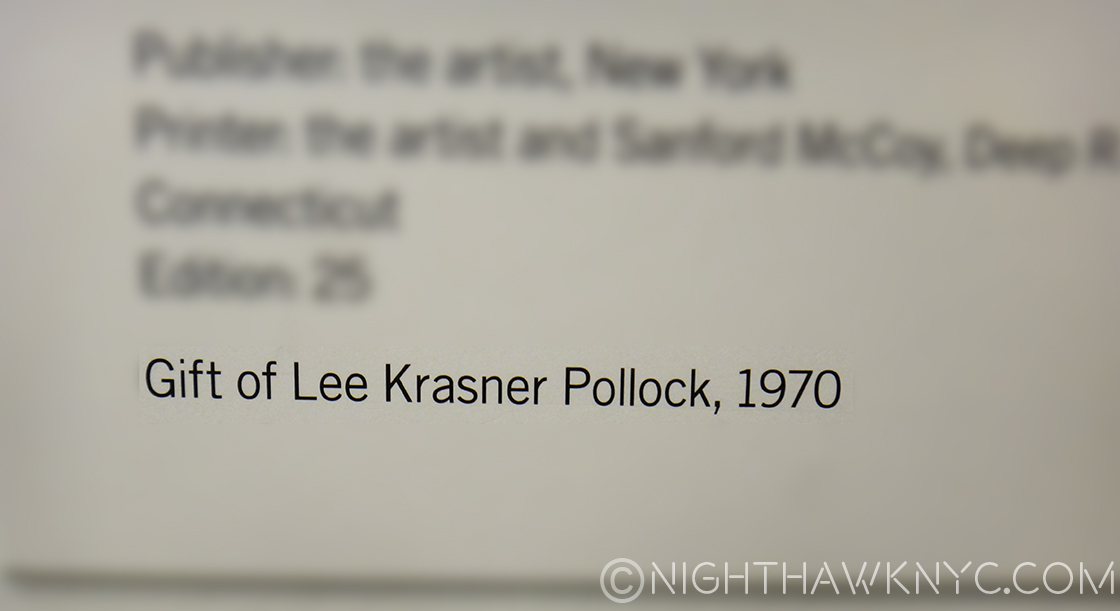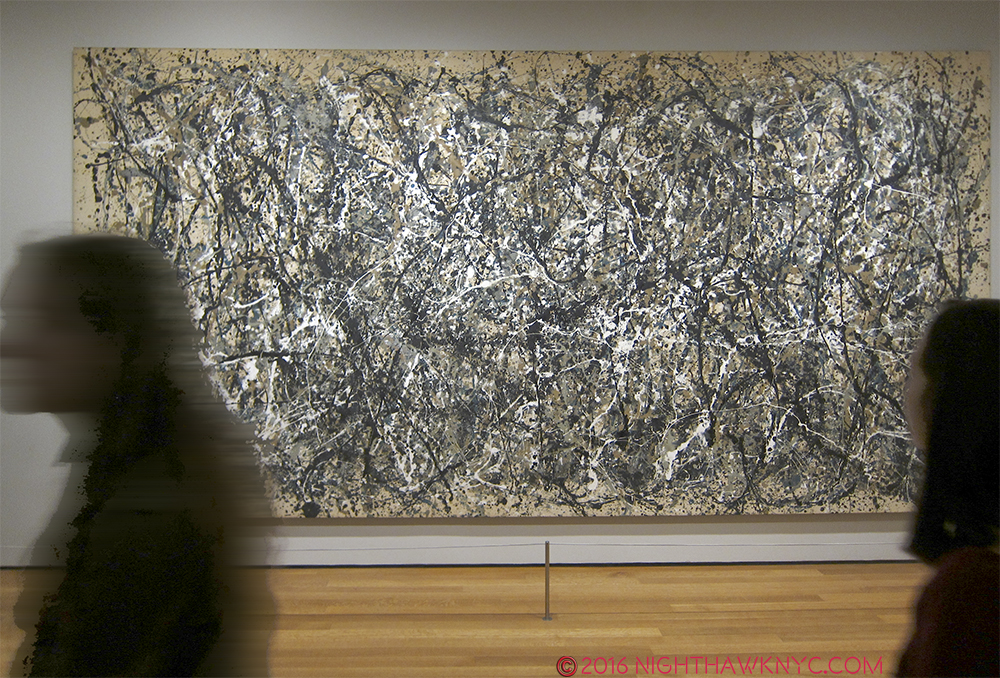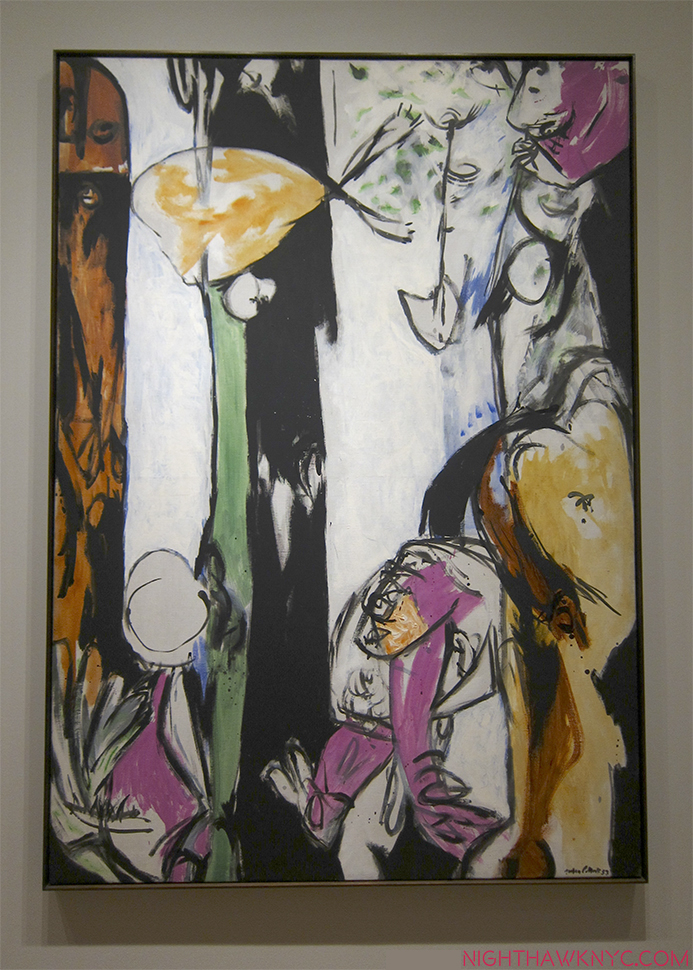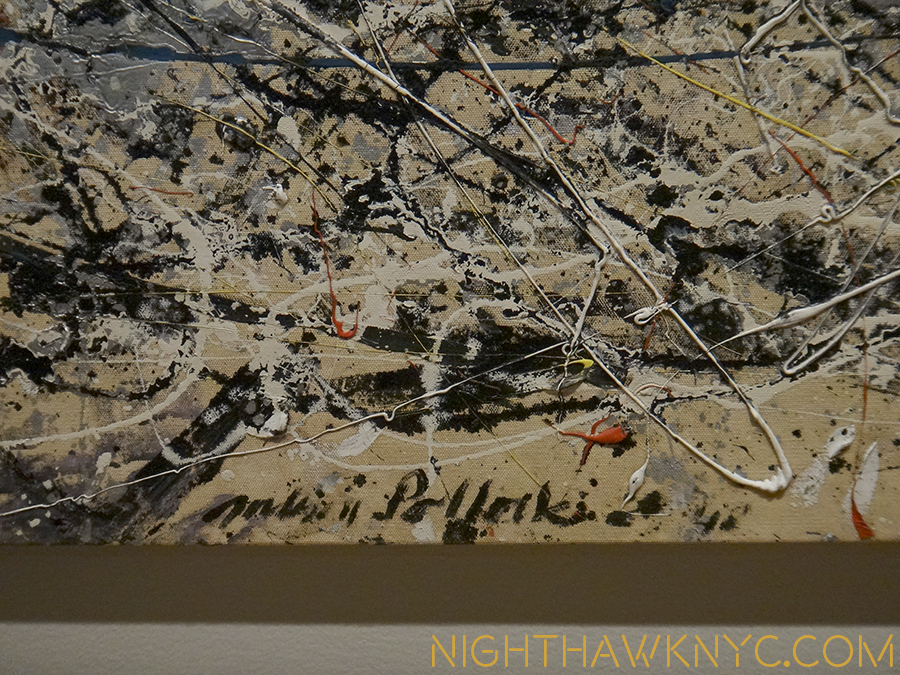This site is Free & Ad-Free! If you find this piece worthwhile, please donate via PayPal to support it & independent Art writing. You can also support it by buying Art & books! Details at the end. Thank you.
Written & Photographed by Kenn Sava (*- unless otherwise credited)
Jackson Pollock’s most famous works are so well known that many people think he painted using what’s (inaccurately) known as his “drip technique” his whole career. It seems there is always one of these radical, unprecedented works he created between 1947 through 1952 on display in about every large American Museum, works that garner as strong a reaction today as they did in the 1950’s. More recently, many probably came to him from the 2000 film, “POLLOCK”(all CAPS in red) with Ed Harris and Marcia Gay Harden, a personal labor of love for Mr. Harris that is quite well done, though it won’t give you a real sense of the road Jackson Pollock’s work traversed on the way to becoming “POLLOCK,” the one-name Icon the film takes for granted you know going in is JACKSON Pollock. The film’s poster (an homage to Hans Nemuth’s and Martha Holmes’ classic photos of the real Jackson Pollock at work in those later years) so memorably depicts the Artist hard at work, revolutionarily, on the floor and not at an easel, possibly in the act of creating one of those famous later works, that I often hear referred to as “Pollocks.” If you think that “Pollock” was “Jack The Dripper,” as Life Magazine called him, like most labels applied to Artists, it doesn’t tell the whole story about even those works, let alone what came before, and after.
To see beyond the Icon, at MoMA’s Jackson Pollock: A Collection Survey, 1934-54, up through May 1, one is able to follow the outline, if not the detail, of his development in the space of only 3 galleries1, and see illuminating works before he achieved worldwide fame when Life Magazine famously asked- “Jackson Pollock: Is he the greatest living painter in the United States?” on August 8, 1949.
He began out west, hanging around with and taking classes with another late 20th Century American Master, Philip Guston2. After Pollock’s brother, Charles, also an aspiring Artist (and later an accomplished Artist in his own right), came to NYC and was studying at the New York Art Student’s League, still on West 57th Street, with no less than Thomas Hart Benton, he told Jackson about it which led to his moving here and joining him with Benton3 at the ripe age of 18.
Benton went from being a fairly well known artist during his life to being eclipsed for most of the past 40 years or so (as was realism in Art in the age of Abstraction and Pop, thanks, in part, to his former student). Recently, Benton seems to be enjoying increased attention, helped by the return to view of his New School Murals after their donation to The Met, where they are now beautifully on display.
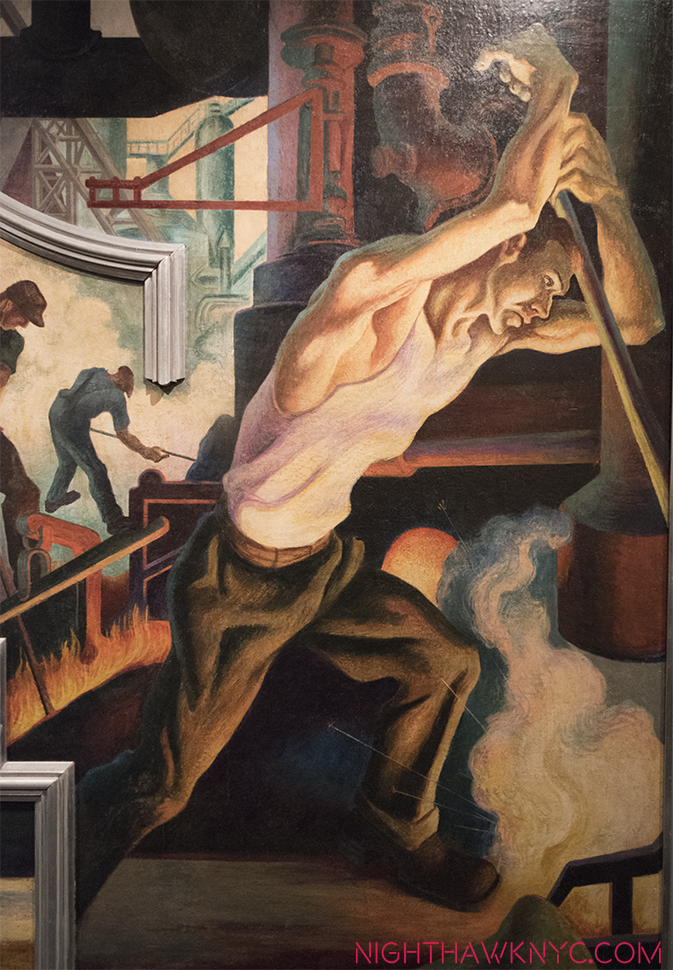
Yes, It’s 18 year old Jackson Pollock posing for his teacher, Thomas Hart Benton’s mural, America Today, now at The Met.
Benton was a resolutely figurative painter (I have seen one or two “abstractions” he did that may have been studies, and there are definitely elements of his “stretching” forms the way El Greco did that border on the fantastic if not the abstract. Some of these elements can be seen in the early Pollocks on display here). Pollock became, perhaps, the furthest thing from a Realist, Abstraction being the polar opposite of Realism4. Yet, early on, you can see fascinating traces of Benton’s influence in the developing student as he experiments with both mainstream and “fantastic” elements of Benton’s work. The two share an interest in the West (JP was born in Cody, Wyoming) and Midwest, themes which occupy many of the early work seen here in the first room. Contrary, also, to the “Pollock myth,” Jackson Pollock was not always a New York City Proto-Beat (if he ever was one) dreamer/visionary. Gradually, the “known world” disintegrates and the figure soon follows. By the time of The She Wolf, from 1943, the last piece in the first room, “representational” Art is on the run to point that very close looking is required to see her.
What’s apparent to me, even early on, is that Pollock had the most amazing, even with Picasso notwithstanding, unprecedented freedom in his approach, and this skill(?), vision(?) became the center of all his future developments. As he broke free from the influence of Benton, he learned to trust his gut more and more, and this extended to virtually reinventing the technique of painting, sometimes from work to work, as he needed to, culminating in the sublime works from 1947-52, where he dripped paint from the can along with a wide range of other techniques- whatever it took to get his desired end.
“Oh I am a lonely painter
I live in a box of paints
I’m frightened by the devil
And I’m drawn to those ones that ain’t afraid”*
Having made so many trips to the New Whitney Museum, I’ve been face to face with the incalculably large debt Art lovers owe to, at least, two women there- founder (and overlooked Sculptor) Mrs. Gertrude V. Whitney, of course, and to Josephine Hopper, Edward’s spouse and widow, who facilitated her husband’s wish that his archives go to the Whitney (she also included hers of her own work). Here, at Moma, I’m struck, again, by a similar feeling- look closely at the tags and you’ll see that many of the works here are “The Gift of,” or from the “Bequest of” another woman, spouse and widow- Lee Krasner.
All 3 women were artists in their own right. Jo Hopper and to a large extent, Lee Krasner put their own creative lives on hold for their husband’s. Oddly, a wonderful Krasner is on view UPSTAIRS on 5. It’s from 1949, right in the time period of many of these works.
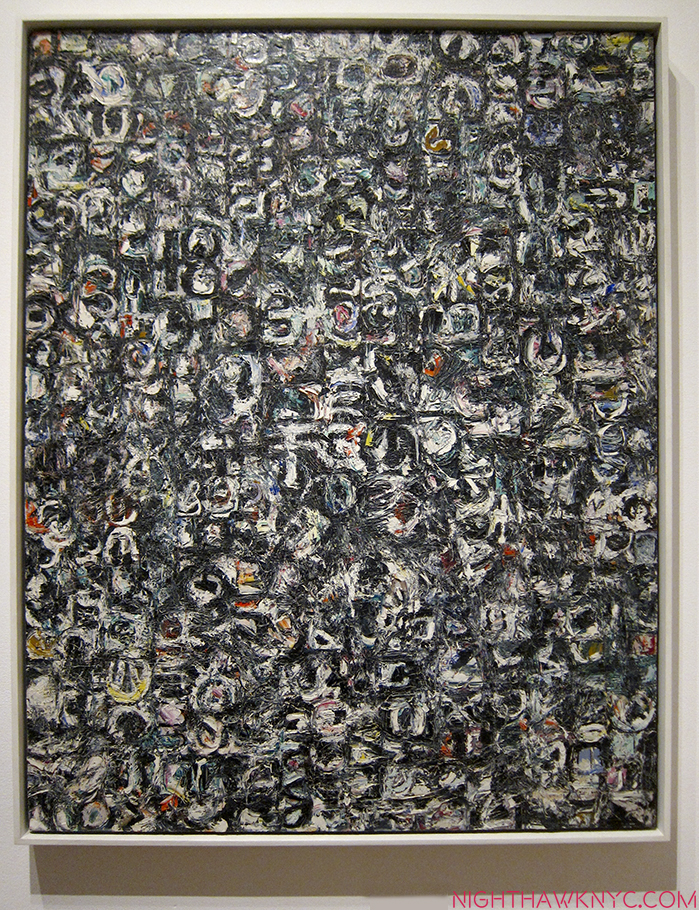
Lee Krasner, Untitled, 1949. NOT in this show! It’s on view on the 5th Floor. I’m putting it where it belongs.
So? Why isn’t it in this show? Possibly because of space, but they might have mentioned it being on view. At least it hasn’t suffered the fate of (possibly) all of Josephine Hopper’s work that she gave to the Whitney, with Edward’s estate- It was discarded BY THE WHITNEY as being subpar!5 A search for her on the Whitney’s website turns up none of her Art. That’s an incalculably stupid move! Gone is the chance to gain the insights into their relationship they may hold, let alone any ongoing appreciation of her own accomplishment! That’s gratitude for you. Coincidentally, there is a biography of Krasner by Hopper’s biographer, Gail Levin.
I bring this all up because I feel that Lee Krasner is the hidden star of the show. In addition to all the work that’s here largely because of her, it’s tempting to see the effect of Jackson Pollock’s having met her (in 1942) in his work. Turning the corner into Room 2 of the show you see something surprising, even shocking, yet apparent, at least to me- joy, light, happiness, even, even though Pollock’s work has become fully abstract. It’s Pollock’s Shimmering Substance from 1946-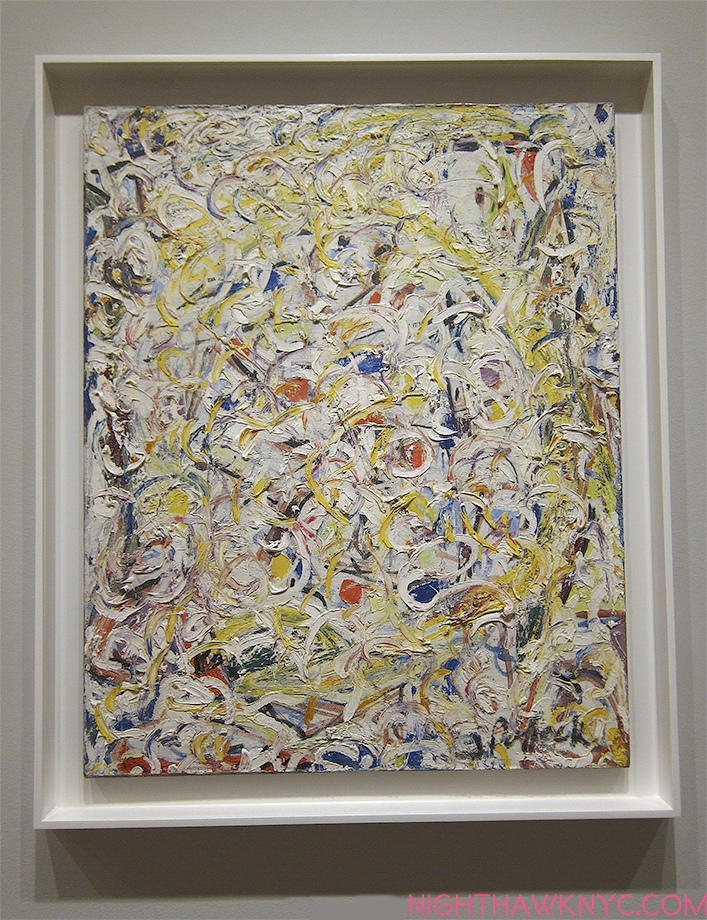
“I met a woman
She had a mouth like yours
She knew your life
She knew your devils and your deeds
And she said
“Go to him, stay with him if you can
But be prepared to bleed”*
After they married in 1945 the two moved to Springs, near East Hampton, Long Island, to get away from the City. Having visited Pollock’s house and studio (an indelible experience) while walking the grounds, I was taken by something I’ve never heard mentioned regarding 1947-1952 Pollock, the so-called “drip” years. When you walk down along the water there and look at the sand, you’ll see the seaweed that’s been washed up on the shore form these black lines. Against the yellow/golden sand, they look uncannily like the “black poles” you see in many of these pieces. And when you walk through the tall grasses in the area, all sorts of seeds, bugs, dust, and who knows what gets disturbed and becomes airborne. To this day, I can’t look at these classic Pollocks and not see something very similar- all those dots and spots in the works so remind me of that experience and what it really looked like.
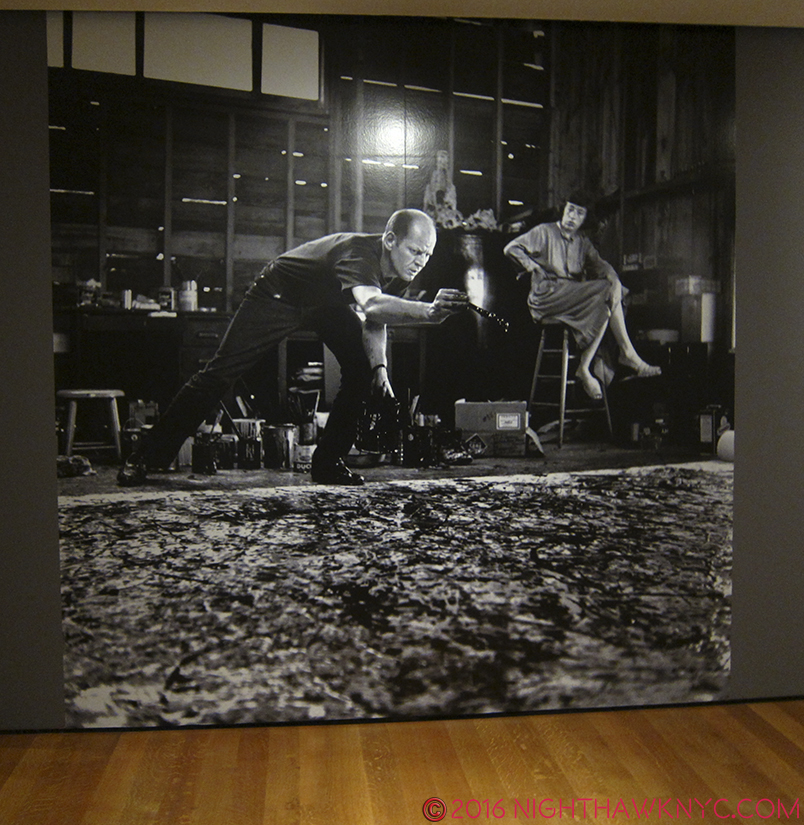
Being in that studio, about 50 year later, was an experience I can only characterize as spiritual. Oh! And there’s a Lee Krasner sighting! (At the show’s entrance)
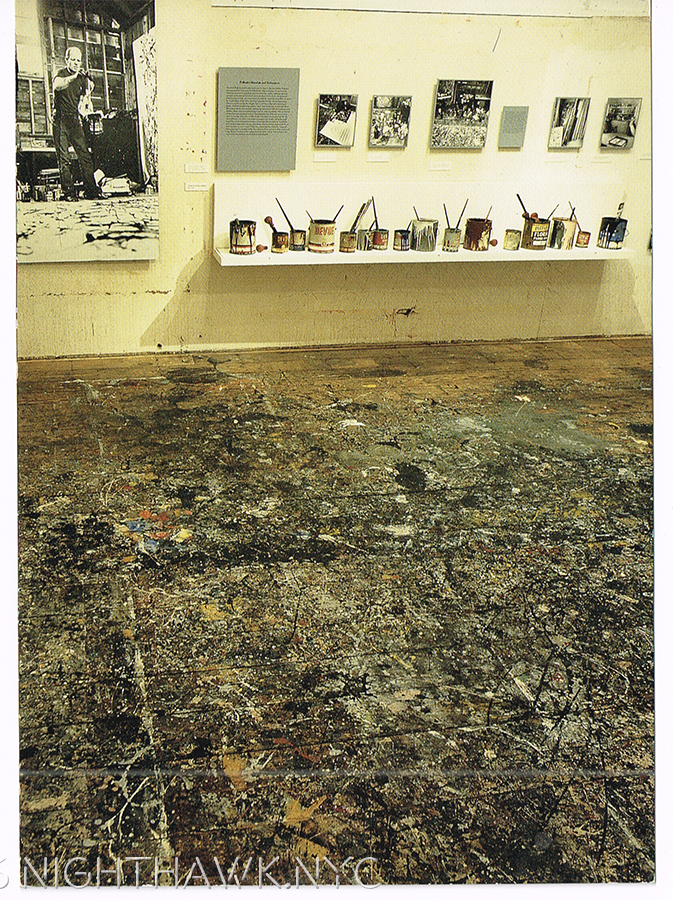
What does this remind you of? It’s Pollock’s Studio Floor, as it appeared when I was there in 1999. They provided these plastic booties, but there was no way I was going to walk on it- it’s a work of Art unto itself. Even in this picture (from a postcard I bought there), I think you can feel the aura of the place.
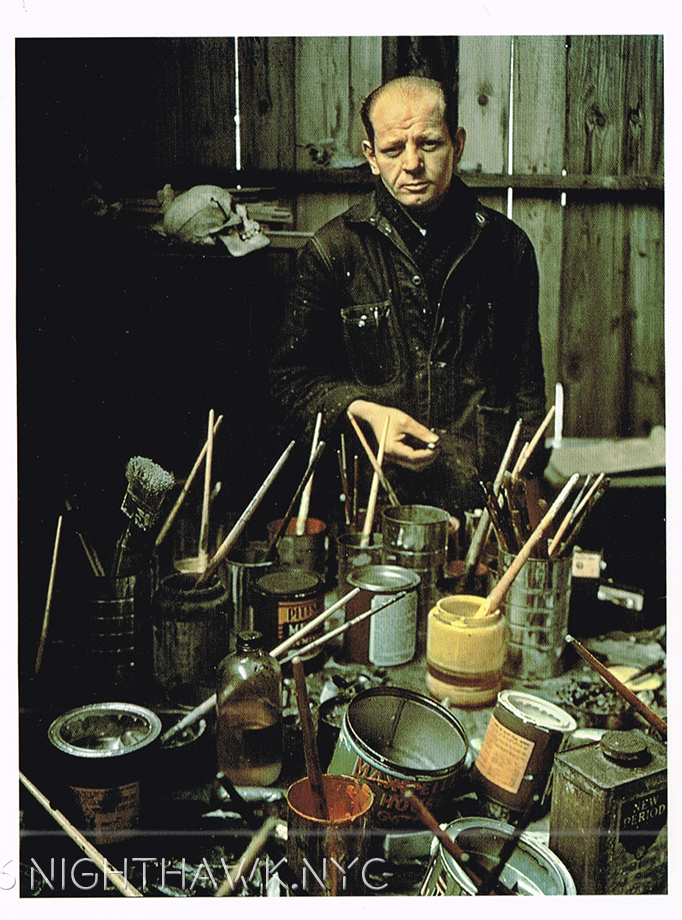
Jackson Pollock, looking Iconic, in his Studio by Arnold Newman, 1949. From a Postcard I got at the big Pollock Retrospective at Moma in 1998, the excellent website for which is still up..
“I remember that time you told me you said
“Love is touching souls”
Surely you touched mine
‘Cause part of you pours out of me
In these lines from time to time
Oh, you’re in my blood like holy wine
You taste so bitter and so sweet
Oh I could drink a case of you darling
And I would still be on my feet
I would still be on my feet”*
So, for me at least, these Jackson Pollock classics have more of a sense of “realism” than they may for some.
“Just before our love got lost you said
“I am as constant as a northern star”
And I said “Constantly in the darkness
Where’s that at?
If you want me I’ll be in the bar”*
Unfortunately, the happiness and tranquility of their new life together wasn’t destined to last. Whatever the demons were (and they will probably be argued about for as long as Van Gogh’s have been), they manifested in his life, and in his work. Selden Rodman is quoted in the Pollock Anthology, Such Desperate Joy, talking about this period and the Artist’s struggles- “He had been trying to freshen up or diversify his style by reintroducing figures, or at least figurative patterns, in the maze of paint.6.” Though represented here with only a few pieces, it seems to me that Pollock “lost his fastball” after 1952. While the most common reaction to his classic period was famously “My 5 year old can do that,” (Really? Try it. It’s not THAT easy), after 1952, even Jackson Pollock seemed not to be able to do them any more. Or? He wanted to move on…but to what?
Yes, his life ended tragically and far too early. I’m not interested in a tell-all about his demons, or scandals or the nights drinking at the Cedar Tavern, where I’ve spent a few myself. I’m interested in that incredible freedom you can see in almost all of his work. How was he able to make a composition hold together while continually creating new styles and using new techniques? Where did that come from?
“Oh but you are in my blood
You’re my holy wine
You’re so bitter, bitter and so sweet
Oh, I could drink a case of you darling
Still I’d be on my feet
I would still be on my feet”*
In the end, Jackson Pollock strikes me as one of the “most” American of painters in the 20th Century, if not ever. I’m not speaking of patriotism or anything nationalistic. I’m speaking about organically American. His work was born in the freedom of the wide open spaces of the west and midwest, but most importantly speaks to the freedom each of us has…
if we choose not to repress it, but to acknowledge it, nurture it, develop it and use it.
Interesting timing for such a show.
*-Soundtrack for this Post is “Case of You,” by Joni Mitchell, (who is also a Painter- FOR 69 YEARS, according to her website!), from her timeless album, Blue, 1971. Published by Sony/ATV Music Publishing.
NighthawkNYC.com has been entirely self-funded & ad-free for over 8 years, during which 300 full-length pieces have been published! If you’ve found it worthwhile, PLEASE donate to allow me to continue below. Thank you, Kenn.
You can also support it by buying Art, Art & Photography books, and Music from my collection! Art & Books may be found here. Music here and here.
Written & photographed by Kenn Sava for nighthawknyc.com unless otherwise credited. To send comments, thoughts, feedback or propositions click here. Click the white box on the upper right for the archives or to search them. Subscribe to be notified of new Posts below. Your information will be used for no other purpose.
- MoMA owns many more Pollocks not on view here. ↩
- Their adventures are chronicled in Guston’s daughter’s, the Breast Cancer Activist, Musa Meyer’s book, Night Studio. ↩
- For more on Charles & Jackson’s relationship and to see some of Charles’ work, check out American Letters: 1927-47, a collections of letters among the Pollock family. It’s a revealing document of trying to survive as an Artist in the Depression and on. ↩
- Which reminds me that I heard Richard Estes say at MAD that “in abstract art there are no mistakes” ↩
- “They arranged for some of her paintings to be given away; they simply discarded the rest.” Edward Hopper; An Intimate Biography by Gail Levin p. xvi ↩
- p. 49 ↩

